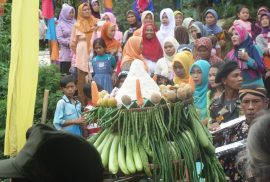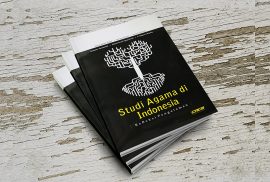CRCS lecturer Greg Vanderbilt shares his reflections while visiting Christians in Indonesian peripheries observing their religious commemorations.
Gregory Vanderbilt
Anang G. Alfian | CRCS | Article

“Jesus as an infant fled with his family into exile. During his public life, he went about doing good and healing the sick, with nowhere to lay his head”.
We were finally in the next to last meeting of Religion and Globalization class. Having studied religion and globalization through the whole sessions, we have come to understand a lot about what role of religions play in accord to globalization and how globalization affects the way religions are concerned with humanitarian issues.
On Monday, November 21, 2016, we had a field trip to one faith-based-NGO to understand how such religious organization works for humanity. Jesuit Refugee Service (JRS) is one of the well-known international organizations and it was a good place to learn the working field of faith-based organizations. Together with Gregory Vanderbilt as the lecturer of the class, we visited the national office of JRS in Yogyakarta and had a great time meeting Fr. Maswan, S.J., and learning directly from a member of the community
 Our visit began with Fr. Maswan’s presentation about the organization. Firstly established in Indonesia in 1999, Jesuit Refugees Services has been accompanying, advocating, and giving services to forcibly displaced people. Therefore, this organization has actually been well experienced in dealing with the issues. As we listen to his presentation, we come to realize that this problem of refugees and asylum seekers cannot be ignored for it belongs to international concern. The perpetuation of war, disasters, racial conflict, and many other causes make refugees seek for their safety life by migrating to other national boundaries.
Our visit began with Fr. Maswan’s presentation about the organization. Firstly established in Indonesia in 1999, Jesuit Refugees Services has been accompanying, advocating, and giving services to forcibly displaced people. Therefore, this organization has actually been well experienced in dealing with the issues. As we listen to his presentation, we come to realize that this problem of refugees and asylum seekers cannot be ignored for it belongs to international concern. The perpetuation of war, disasters, racial conflict, and many other causes make refugees seek for their safety life by migrating to other national boundaries.
However, it has never been easy for refugees because they have to face the legal and often difficult administrative regulations of the government where they are staying. This is exactly what happens to refugees in Indonesia. Because Indonesia has not ratified the 1951 Convention Relating to the Status of Refugees, refugees in Indonesia are not recognized as such by the Indonesian government—instead they are considered undocumented aliens—while they wait for recognition from the UNHCR which will allow them to resettle in another country. In some districts, refugees have to stay in detention center while waiting for their legal refugee status to be acknowledged by the law.
As recorded in JRS monitoring, refugees in Indonesia have reached a number of 4.344 people of whom 540 are female and 905 are children with 96 being unaccompanied minors and seperated children. So far, JRS has been accompanying two detention centers in Surabaya and Manado and being involved in other areas as well. In Aceh, JRS has advocated for protection over 625 people and has given psychosocial accompaniement to over 1558 refugees. In Yogyakarta, they are serving the refugees, mostly from Afghanistan, housed in the Ashrama Haji. They listen, accompany, and make activities to give hope for those people who had been separated from their family and their mother land.
So, where is exactly the religion to deal with this? This question come out of students trying to figure out the role of religion in this humanity organization. Then, the community member continued the presentation stating that the mission of JRS is intimately connected with the mission of Society of Jesus to serve faith and promote the justice of God’s kingdom in dialogues with cultures and religions. Yet, another student comes up with another concern, “Does it mean that JSR proselytize Christianity?” Well. This is very important because in the previous meeting, we read through Philip Fountain’s “Proselytizing Development” and he himself attended our class for discussing this topic. In sort, the religion has been inspired by the development organization as precedent in history while, vice versa, religion brings universal ethics to be put in dialogue with cultures and religion.
 In the last session of our discussion in JRS offices, Fr. Maswan emphasized some points such as it is the problem of humanity that we have to be concerned about and not at all concerned in religious kind of missionary work altough it might inspired the organization in its underlying ethics, building cooperation with other cultural, faith-based, and other types of organization. We also read the paper Fredy Torang (2013 batch) presented in Singapore about how JRS acts as an agent of “humanitarian diplomacy” between the refugees and the local communities and government. In 2017, JRS will continue lobbying local government to allow refugees to live in a community and not in detention and also monitoring the migration all over the world to help assisting the displaced people and consistently gives concern to human right and dignity.
In the last session of our discussion in JRS offices, Fr. Maswan emphasized some points such as it is the problem of humanity that we have to be concerned about and not at all concerned in religious kind of missionary work altough it might inspired the organization in its underlying ethics, building cooperation with other cultural, faith-based, and other types of organization. We also read the paper Fredy Torang (2013 batch) presented in Singapore about how JRS acts as an agent of “humanitarian diplomacy” between the refugees and the local communities and government. In 2017, JRS will continue lobbying local government to allow refugees to live in a community and not in detention and also monitoring the migration all over the world to help assisting the displaced people and consistently gives concern to human right and dignity.
Gregory Vanderbilt | CRCS UGM | Perspective

The kyai switched to English for just one sentence as he joined other village leaders in welcoming CRCS’s Eighth Diversity Management School or Sekolah Pengelolaan Keragaman (SPK) to the village of Mangundadi, 23 km west of Magelang, at the foot of Mt. Sumbing. Perhaps his choice was to honor the diversity present in this group—or that the chasm from ivory tower to mountain village had been bridged for an afternoon—as we tried to absorb the dance performance based on the carved reliefs of Borobudur we had just experienced. Though the village is 24km away from the 10th-century sacred site, and Muslim, it and its arts are part of the Ruwat-Rawat Festival movement that seeks to re-sacralize the great Buddhist monument from the disenchantment of the tourism industry and the weight of the busloads that climb it each day to snap selfies and admire in passing the craftsmanship of a millenium ago.
We were there because of the friendship with Ruwat-Rawat founder Pak Sucoro that has developed over the last year thanks to CRCS alumna Wilis Rengganiasih. Owner of the counter-narrative-producing Warung Info Jagad Cleguk across from the gates to the Borobudur parking lot and instigator of the eight-week festival each April-May, he had arranged an amazing afternoon for the excursion that has become an important change-of-page for SPK members after a week of ideas and passionate discussion. On the Saturday of the ten-day long school, the twenty-five members of SPK plus facilitators and friends departed by bus the school’s venue at the Disaster Oasis in Kaliurang, heading first to the warung at Borobudur to meet our guides and then heading another hour west from Magelang.
The road to the village of Mangundadi was too steep for our bus and so we were met at the main road by the pickups and motorcycles of the young men of the village. Having climbed on board, off we went to Mangundadi, the motorcycles revving their engines in a chorus of welcome. Afterwards SPK staffer Subandri admitted that he has now a tinge of positive feeling when he hears the youth gangs disrupt the city streets with their noisy machines, because what a welcome it was! When we reached the village, women lined the lane to shake our hands as we were ushered into one house to catch our breath, and then to process around the village’s new mosque with the genungan ritual mountain of vegetables, followed by the groups of performers, children, youth, adults, already in gorgeous costume and make-up. By the time we had feasted in another house, the performers were ready and, as the rain fell, they danced scenes from the stone reliefs. In the end, Pak Sucoro pulled some of us onto the stage to move with them and then they offered their salims and went back to their villages.
 In the evening we returned to the Omah Semar retreat house near the monument-park for a discussion with Pak Sucoro about his vision of Borobudur as a universal spiritual heritage and as a place of spiritual significance for local culture, a place for Indonesian society to make a new choice, to live in harmony with God, nature, and each other. The Ruwat-Rawat has incorporated and re-ignited local traditions by focusing them on a global question, the question I asked the Advanced Study of Buddhism students who met Pak Sucoro back in May: who owns Borobudur? The next morning, walking across the lawns where his village once stood, we could see the stupa-monument in a new way.
In the evening we returned to the Omah Semar retreat house near the monument-park for a discussion with Pak Sucoro about his vision of Borobudur as a universal spiritual heritage and as a place of spiritual significance for local culture, a place for Indonesian society to make a new choice, to live in harmony with God, nature, and each other. The Ruwat-Rawat has incorporated and re-ignited local traditions by focusing them on a global question, the question I asked the Advanced Study of Buddhism students who met Pak Sucoro back in May: who owns Borobudur? The next morning, walking across the lawns where his village once stood, we could see the stupa-monument in a new way.
This was my third SPK since I came to CRCS in 2014. For me, it is an opportunity to meet the activists, academics, government workers, and media people who come to participate and see how change is happening across Indonesia. Each SPK may have its own character—this one, for example, was quicker to start singing than put on a mop of cringe-worthy joke telling—but the greater tone of excitement at being among others as serious of purpose and as ready to be challenged to greater intellectual depth is constant. The participants are excited by guest insights from Bob Hefner and Dewi Candraningrum but even more by the well-developed program from a core of facilitators devoted to teaching “civic pluralism” as a paradigm for just co-existence in the contexts of Indonesian diversity, one basing access in the three Re-‘s of recognition, representation, and redistribution, combined with thinking systematically about such core CRCS emphases as taking apart religion as lived and governed in Indonesia, digging into research for advocacy and putting into practice the theories and methods of conflict resolution. Equally important, they stay up late sharing their work, from teaching to preaching to activating NGOs to working conscientiously from inside government. Some know of the program because they have heard about CRCS while visiting or studying in Yogyakarta; others, following friends and co-workers who applied previously; and others still from searching online for “pluralism school” in order to serve better as religious and social leaders.
Visiting SPK alumni in their homeplaces—Jakarta, Aceh, West Sumatra, and Jambi, so far—has also shown me glimpses of grass-roots possibility across Indonesia. Trainings and workshops are regular features of Indonesian civil society, but it appears SPK leaves a more lasting impression on its participants. This is perhaps because of the intensity of their twelve days in the aptly named Disaster Oasis and perhaps because it challenges them more to take an intellectually grounded, hopeful framework to the places they are working and asks them to return with a research project, on how a pluralistically civil society is being made in soccer clubs and local studies movements and activism for gender (five from SPK-VIII work against domestic violence) and ethnic equality and film festivals and women’s economic literacy programs in villages and so on. In that way, the village kyai is right.
*The writer, Gregory Vanderbilt, is a lecturer at CRCS, teaching courses, among others, on religion and globalization; and advanced study of Christianity.
M Rizal Abdi | CRCS | Book Review
Menandai sebuah usia dengan penerbitan sebuah buku bukanlah hal baru di dunia akademik. Boleh jadi hampir setiap pusat studi dan fakultas melakukannya meski tak ajeg, misal dua tahunan atau per lustrum. Bahkan, perayaan ulang tahun seorang professor di masa paruh bayanya kini kurang sahih tanpa penerbitan sebuah karya. Namun, di tengah gempita penerbitan itu, patut dicatat sejauh mana penerbitan buku tersebut tidak sekadar berhenti pada glorifikasi pribadi atau instansi tetapi juga berkontribusi bagi bidang studi yang ia naungi.





